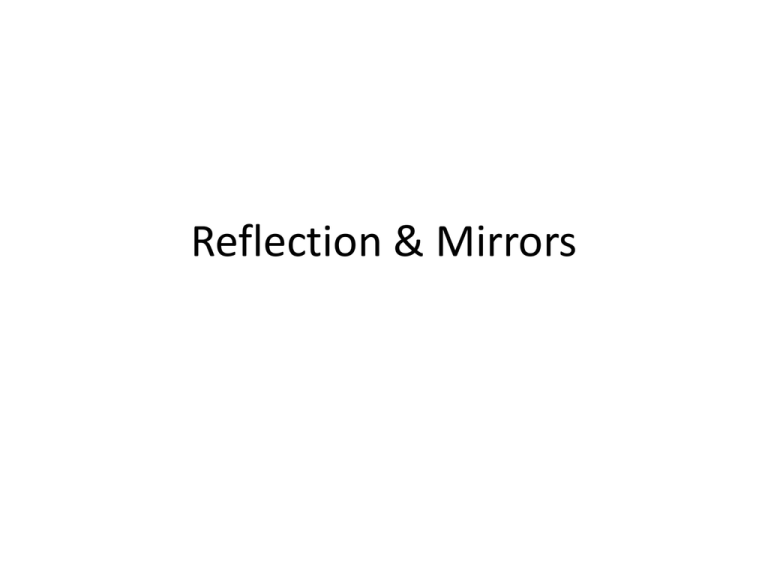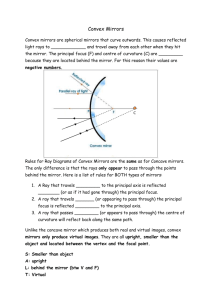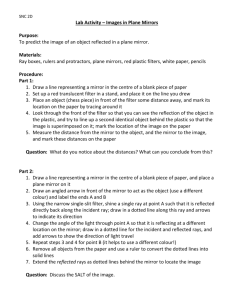Reflection & Mirrors
advertisement

Reflection & Mirrors Recap: Diffuse reflection: gives a blurry image (or none at all) Specular reflection: gives a clear image Mirror types: PLANE CONVEX CONCAVE Plane Mirrors • The image formed by plane mirrors can only be seen behind the mirror. • This is known as a virtual image. • Image is the same size as the object. • Only the right and left of the image is changed. Curved Mirrors • Curved mirrors can be either – concave (making a little cave) – Causes light to converge – convex (vexing out in the middle) – Causes light to diverge Law of Reflection Ray Diagrams • Show path of light from object mirror away from mirror • Allows you to determine the location and properties of an image formed by a mirror or lens Ray Diagram: Basic set-up mirror r (radius of curvature) f (focal length) C (center of curvature) Principal axis F (focal point) ** r = 2f Ray Diagrams: images • REAL vs. VIRTUAL • UPRIGHT vs. INVERTED • SAME SIZE, SMALLER, ENLARGED COMPARE IMAGE TO ORIGINAL OBJECT Real or Virtual Real images can project on a screen Virtual images can only be seen in a mirror Upright or Inverted Upright images are oriented the same as the object Inverted images are oriented in the opposite direction as the object Reduced or Enlarged Reduced images are smaller in size than the object Enlarged images are larger in size than the object Get ready to draw diagrams… • Take 2 different colored pencils • Take a slice of index card/Ruler – This will be your straight-edge – PUT YOUR NAME ON IT & KEEP IT – Decorate it if you want to • Take a notes packet • Ready? Let’s do this! Concave Mirror A Step 5: 1: draw second 2: 3: 4: horizontal reflected image from ray ray ray from principal from from top point top of axis object of where to object intersection through ray tohits mirror focal mirror of reflected point through horizontally torays mirror focalback point F Image is: REAL INVERTED LARGER FARTHER Concave Mirror B Step 6: 1: draw 2: 3: 4: 5: continue reflected second horizontal image both from ray reflected ray ray reflected from principal through from focal rays top ray axis focal point, behind ofto object point through mirror to mirror as top of object, DASHED intersection LINES oftoreflected mirror rays F Image is: VIRTUAL UPRIGHT LARGER FARTHER Convex Mirror Step 6: 1: draw 2: 3: 4: 5: continue reflected angled horizontal image both from ray, reflected ray ray reflected aimed principal from fromat focal rays top ray focal axis behind of point to point, object intersection through mirror to tomirror mirror as of point where DASHED reflected LINES raysray hit mirror and out F Image is: VIRTUAL UPRIGHT SMALLER CLOSER • Questions? • Begin optics packet!



